Management Accounting Report: Financial Planning, Budgeting & Analysis
VerifiedAdded on 2024/05/16
|22
|3908
|355
Report
AI Summary
This management accounting report provides a detailed analysis of financial planning and budgetary control, utilizing both marginal and absorption costing methods to assess a company's financial performance over three years. It includes income statements, cost calculations, and reconciliation statements to highlight the differences between costing methodologies. The report further explains the advantages and disadvantages of various planning tools such as variance analysis, balance scorecards, and ABC costing, emphasizing their application in preparing and forecasting budgets. It evaluates how organizations adapt their management accounting systems to address financial challenges, focusing on financial planning, cost measurement, decision-making processes, and budgetary control. The analysis demonstrates how effective management accounting can lead organizations to sustainable success by improving financial stability and strategic decision-making. Desklib offers a range of similar solved assignments and study resources for students.
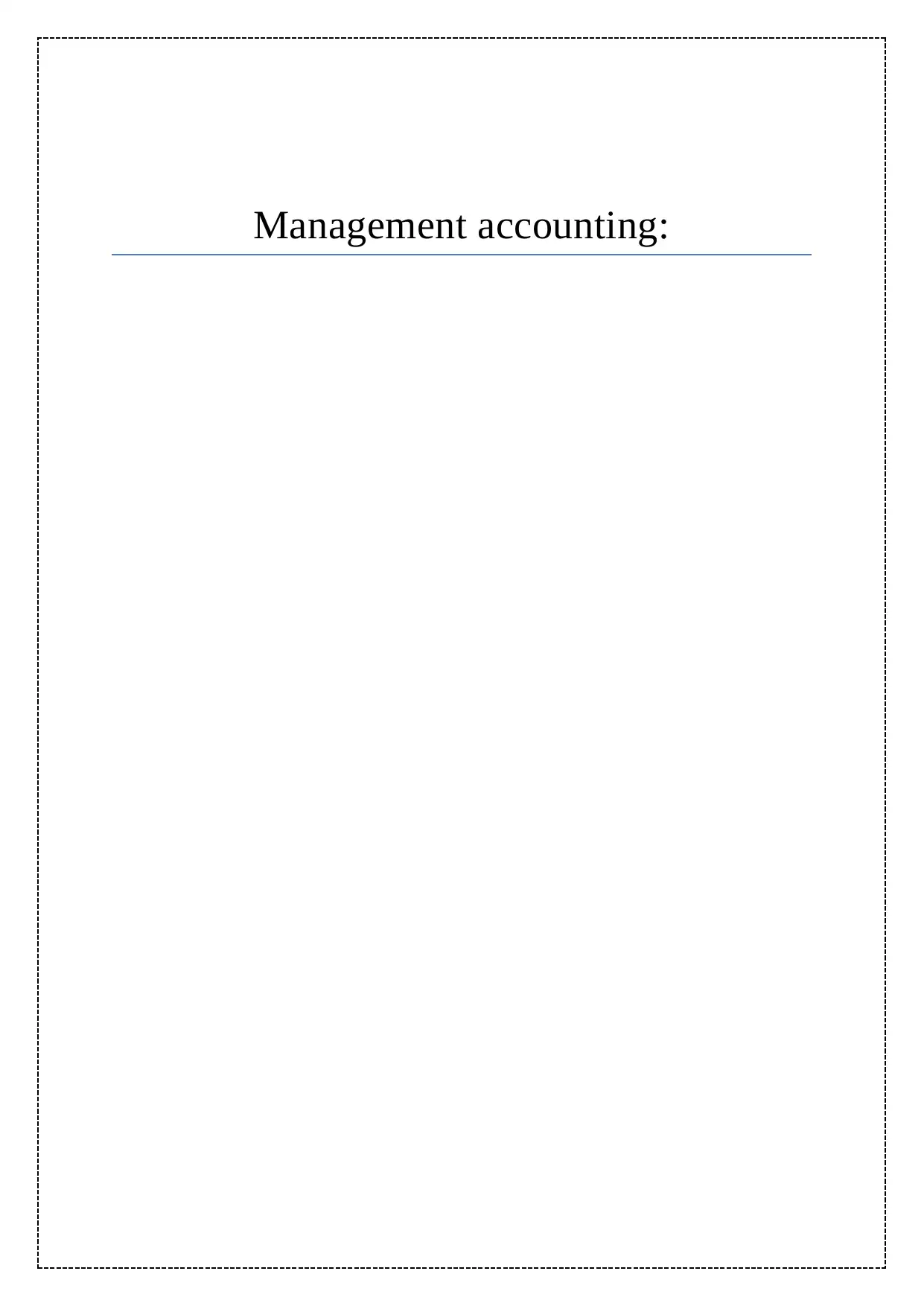
Management accounting:
Paraphrase This Document
Need a fresh take? Get an instant paraphrase of this document with our AI Paraphraser
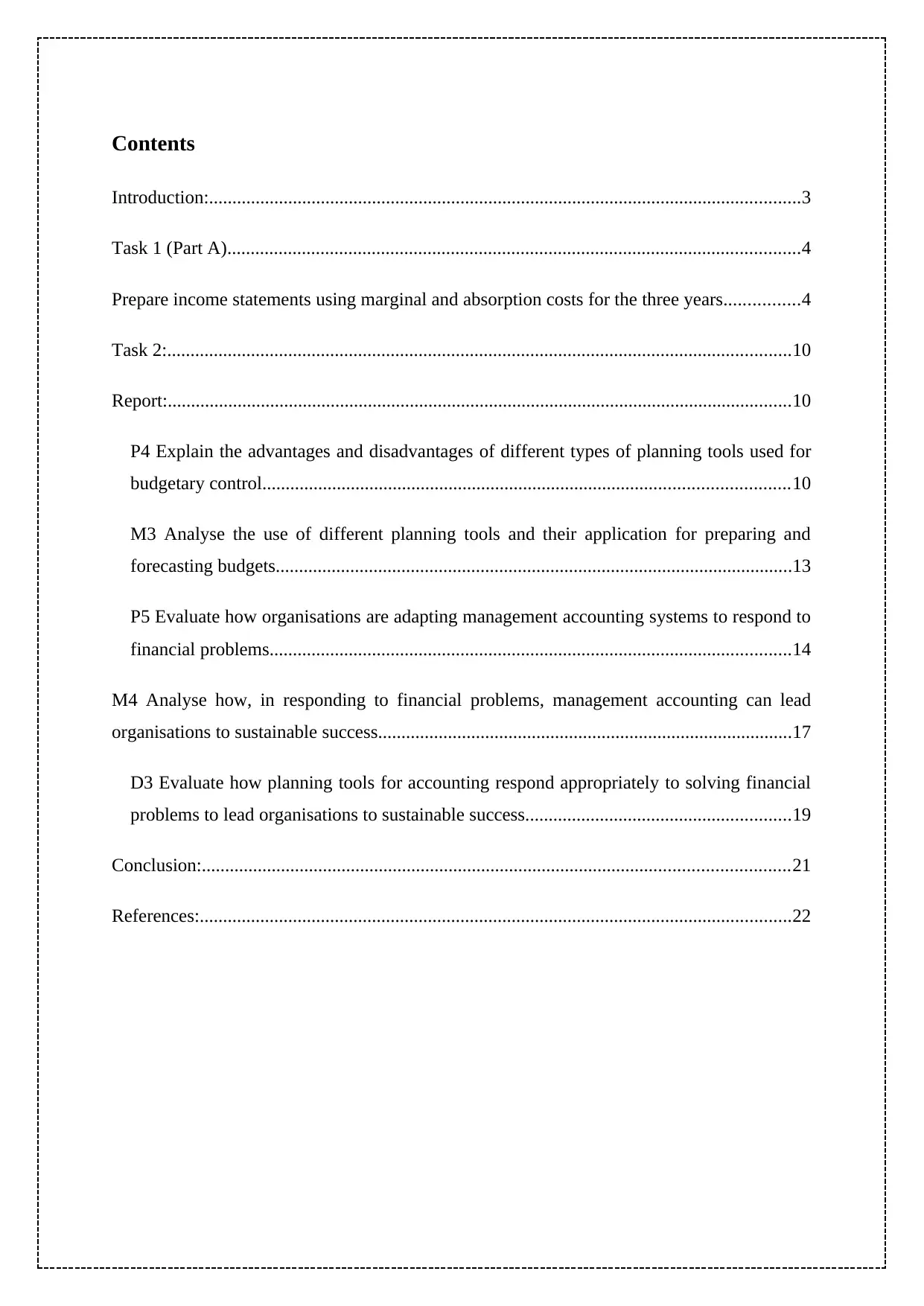
Contents
Introduction:...............................................................................................................................3
Task 1 (Part A)...........................................................................................................................4
Prepare income statements using marginal and absorption costs for the three years................4
Task 2:......................................................................................................................................10
Report:......................................................................................................................................10
P4 Explain the advantages and disadvantages of different types of planning tools used for
budgetary control.................................................................................................................10
M3 Analyse the use of different planning tools and their application for preparing and
forecasting budgets...............................................................................................................13
P5 Evaluate how organisations are adapting management accounting systems to respond to
financial problems................................................................................................................14
M4 Analyse how, in responding to financial problems, management accounting can lead
organisations to sustainable success.........................................................................................17
D3 Evaluate how planning tools for accounting respond appropriately to solving financial
problems to lead organisations to sustainable success.........................................................19
Conclusion:..............................................................................................................................21
References:...............................................................................................................................22
Introduction:...............................................................................................................................3
Task 1 (Part A)...........................................................................................................................4
Prepare income statements using marginal and absorption costs for the three years................4
Task 2:......................................................................................................................................10
Report:......................................................................................................................................10
P4 Explain the advantages and disadvantages of different types of planning tools used for
budgetary control.................................................................................................................10
M3 Analyse the use of different planning tools and their application for preparing and
forecasting budgets...............................................................................................................13
P5 Evaluate how organisations are adapting management accounting systems to respond to
financial problems................................................................................................................14
M4 Analyse how, in responding to financial problems, management accounting can lead
organisations to sustainable success.........................................................................................17
D3 Evaluate how planning tools for accounting respond appropriately to solving financial
problems to lead organisations to sustainable success.........................................................19
Conclusion:..............................................................................................................................21
References:...............................................................................................................................22
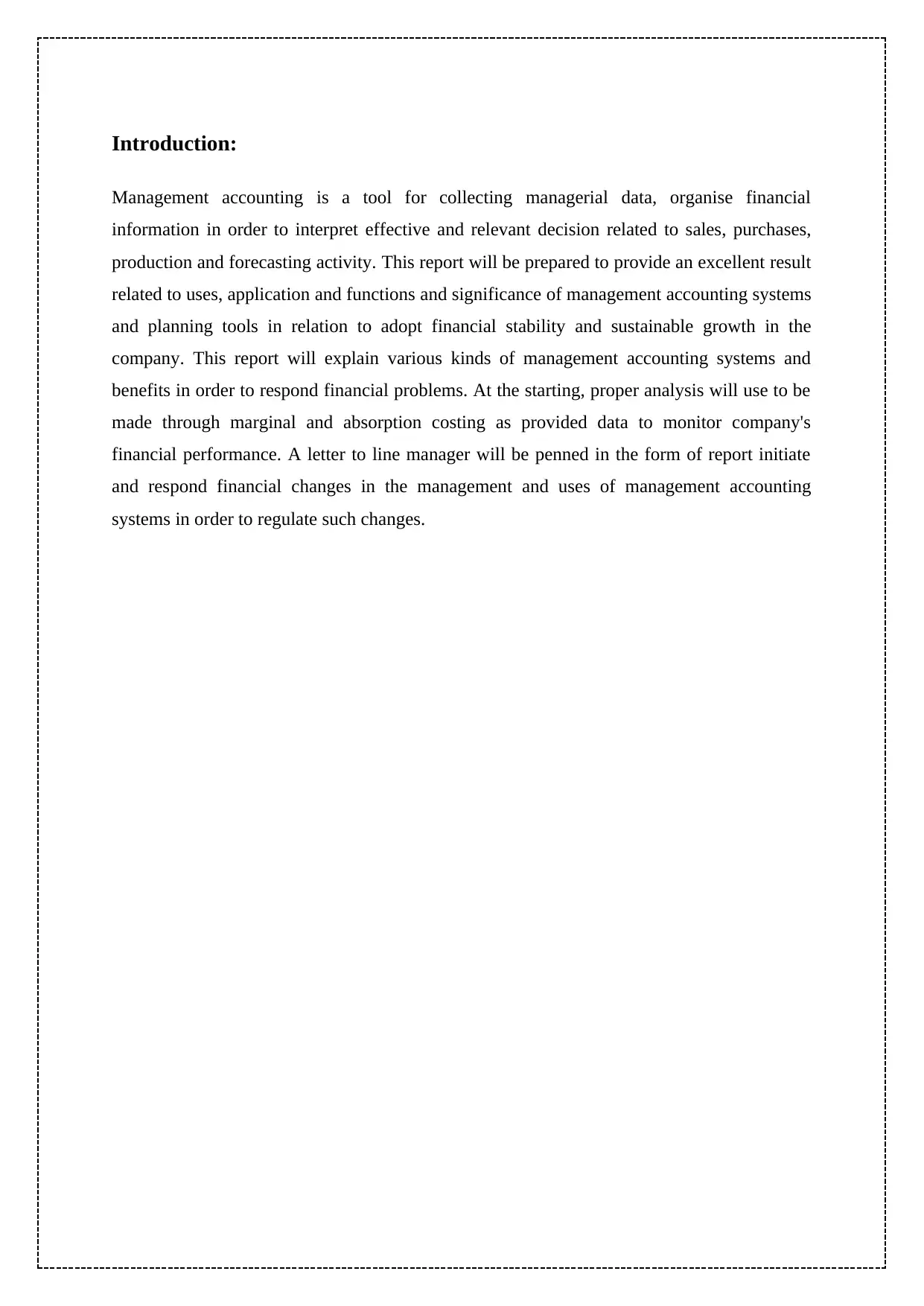
Introduction:
Management accounting is a tool for collecting managerial data, organise financial
information in order to interpret effective and relevant decision related to sales, purchases,
production and forecasting activity. This report will be prepared to provide an excellent result
related to uses, application and functions and significance of management accounting systems
and planning tools in relation to adopt financial stability and sustainable growth in the
company. This report will explain various kinds of management accounting systems and
benefits in order to respond financial problems. At the starting, proper analysis will use to be
made through marginal and absorption costing as provided data to monitor company's
financial performance. A letter to line manager will be penned in the form of report initiate
and respond financial changes in the management and uses of management accounting
systems in order to regulate such changes.
Management accounting is a tool for collecting managerial data, organise financial
information in order to interpret effective and relevant decision related to sales, purchases,
production and forecasting activity. This report will be prepared to provide an excellent result
related to uses, application and functions and significance of management accounting systems
and planning tools in relation to adopt financial stability and sustainable growth in the
company. This report will explain various kinds of management accounting systems and
benefits in order to respond financial problems. At the starting, proper analysis will use to be
made through marginal and absorption costing as provided data to monitor company's
financial performance. A letter to line manager will be penned in the form of report initiate
and respond financial changes in the management and uses of management accounting
systems in order to regulate such changes.
⊘ This is a preview!⊘
Do you want full access?
Subscribe today to unlock all pages.

Trusted by 1+ million students worldwide
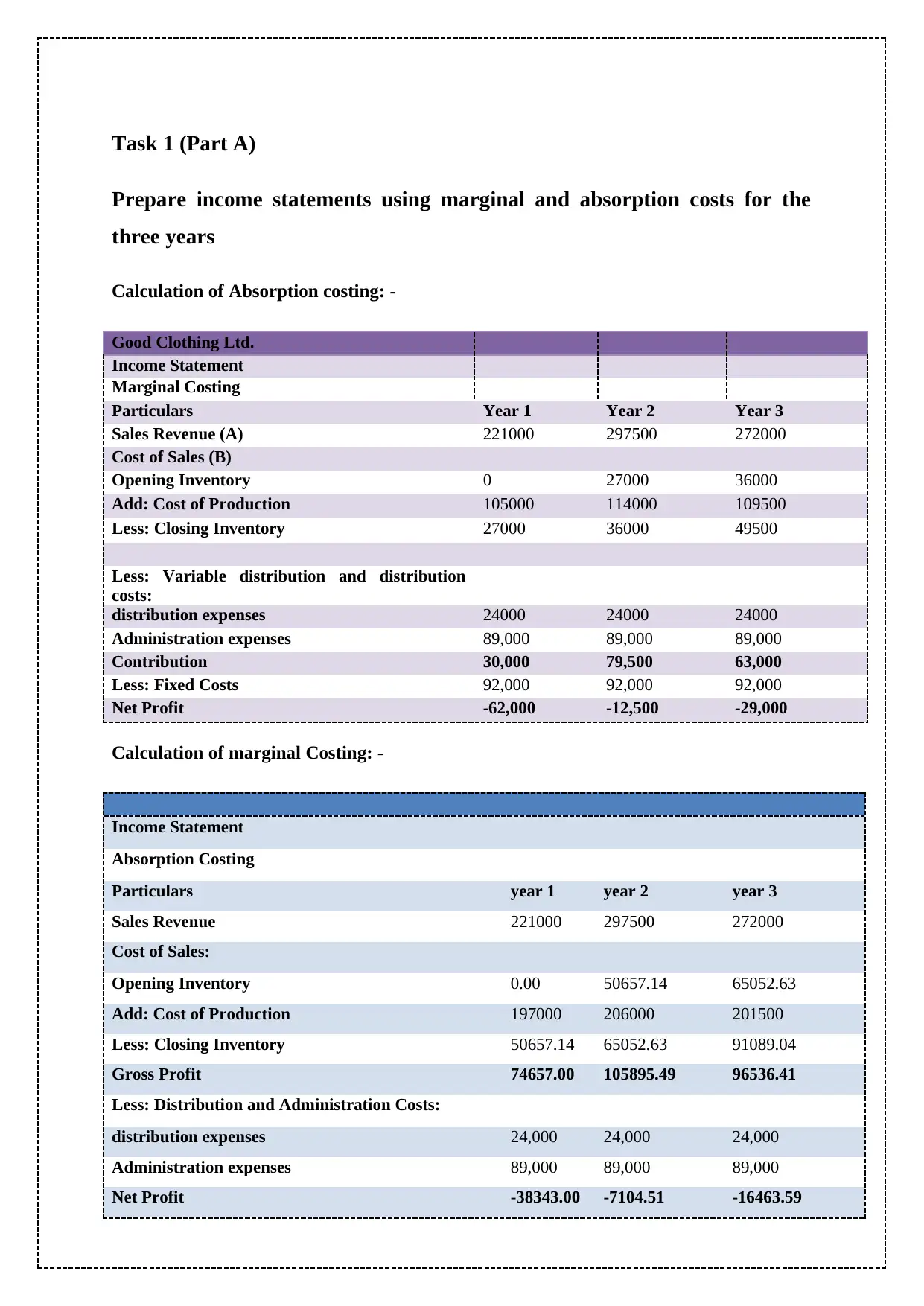
Task 1 (Part A)
Prepare income statements using marginal and absorption costs for the
three years
Calculation of Absorption costing: -
Good Clothing Ltd.
Income Statement
Marginal Costing
Particulars Year 1 Year 2 Year 3
Sales Revenue (A) 221000 297500 272000
Cost of Sales (B)
Opening Inventory 0 27000 36000
Add: Cost of Production 105000 114000 109500
Less: Closing Inventory 27000 36000 49500
Less: Variable distribution and distribution
costs:
distribution expenses 24000 24000 24000
Administration expenses 89,000 89,000 89,000
Contribution 30,000 79,500 63,000
Less: Fixed Costs 92,000 92,000 92,000
Net Profit -62,000 -12,500 -29,000
Calculation of marginal Costing: -
Income Statement
Absorption Costing
Particulars year 1 year 2 year 3
Sales Revenue 221000 297500 272000
Cost of Sales:
Opening Inventory 0.00 50657.14 65052.63
Add: Cost of Production 197000 206000 201500
Less: Closing Inventory 50657.14 65052.63 91089.04
Gross Profit 74657.00 105895.49 96536.41
Less: Distribution and Administration Costs:
distribution expenses 24,000 24,000 24,000
Administration expenses 89,000 89,000 89,000
Net Profit -38343.00 -7104.51 -16463.59
Prepare income statements using marginal and absorption costs for the
three years
Calculation of Absorption costing: -
Good Clothing Ltd.
Income Statement
Marginal Costing
Particulars Year 1 Year 2 Year 3
Sales Revenue (A) 221000 297500 272000
Cost of Sales (B)
Opening Inventory 0 27000 36000
Add: Cost of Production 105000 114000 109500
Less: Closing Inventory 27000 36000 49500
Less: Variable distribution and distribution
costs:
distribution expenses 24000 24000 24000
Administration expenses 89,000 89,000 89,000
Contribution 30,000 79,500 63,000
Less: Fixed Costs 92,000 92,000 92,000
Net Profit -62,000 -12,500 -29,000
Calculation of marginal Costing: -
Income Statement
Absorption Costing
Particulars year 1 year 2 year 3
Sales Revenue 221000 297500 272000
Cost of Sales:
Opening Inventory 0.00 50657.14 65052.63
Add: Cost of Production 197000 206000 201500
Less: Closing Inventory 50657.14 65052.63 91089.04
Gross Profit 74657.00 105895.49 96536.41
Less: Distribution and Administration Costs:
distribution expenses 24,000 24,000 24,000
Administration expenses 89,000 89,000 89,000
Net Profit -38343.00 -7104.51 -16463.59
Paraphrase This Document
Need a fresh take? Get an instant paraphrase of this document with our AI Paraphraser
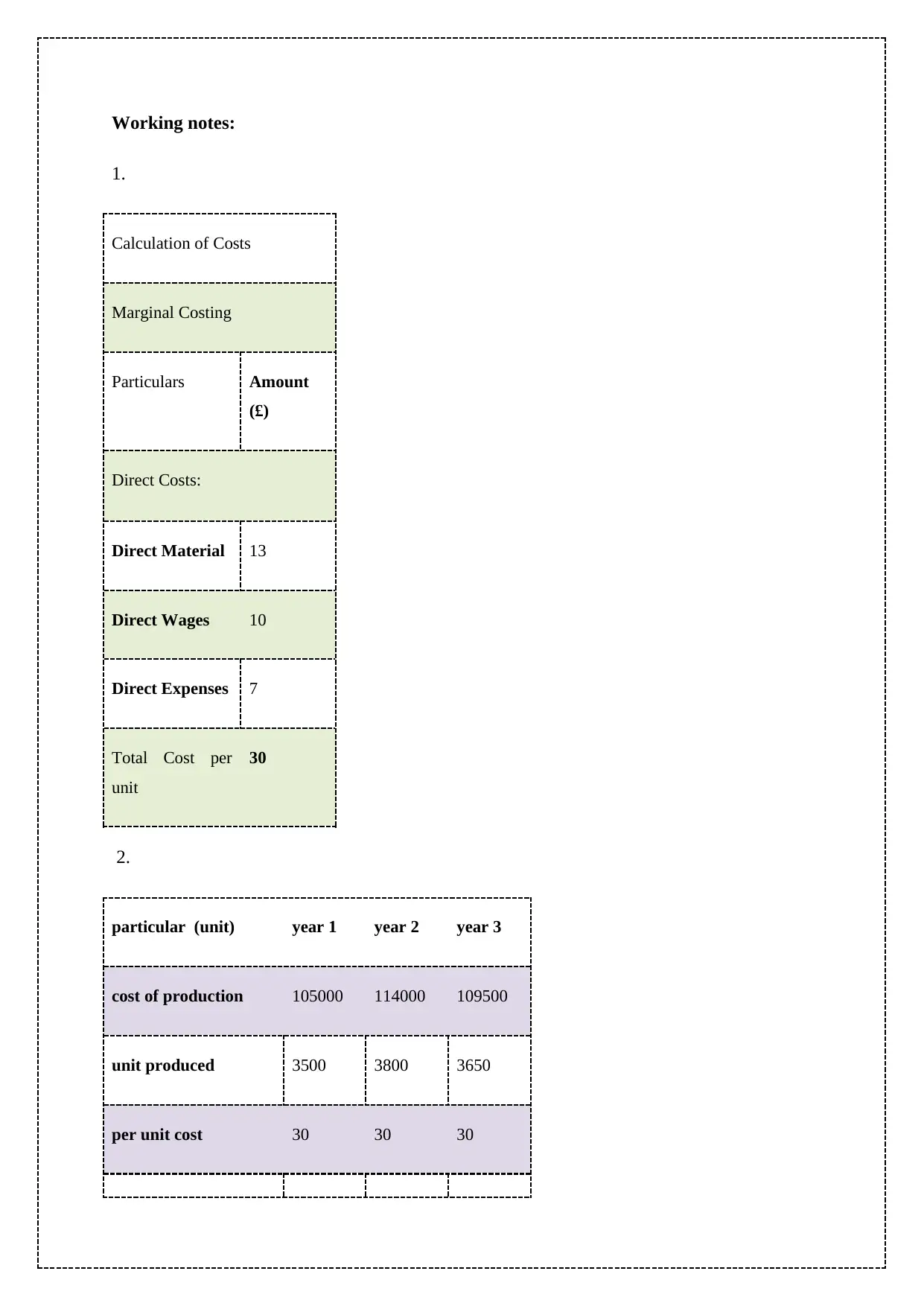
Working notes:
1.
Calculation of Costs
Marginal Costing
Particulars Amount
(£)
Direct Costs:
Direct Material 13
Direct Wages 10
Direct Expenses 7
Total Cost per
unit
30
2.
particular (unit) year 1 year 2 year 3
cost of production 105000 114000 109500
unit produced 3500 3800 3650
per unit cost 30 30 30
1.
Calculation of Costs
Marginal Costing
Particulars Amount
(£)
Direct Costs:
Direct Material 13
Direct Wages 10
Direct Expenses 7
Total Cost per
unit
30
2.
particular (unit) year 1 year 2 year 3
cost of production 105000 114000 109500
unit produced 3500 3800 3650
per unit cost 30 30 30
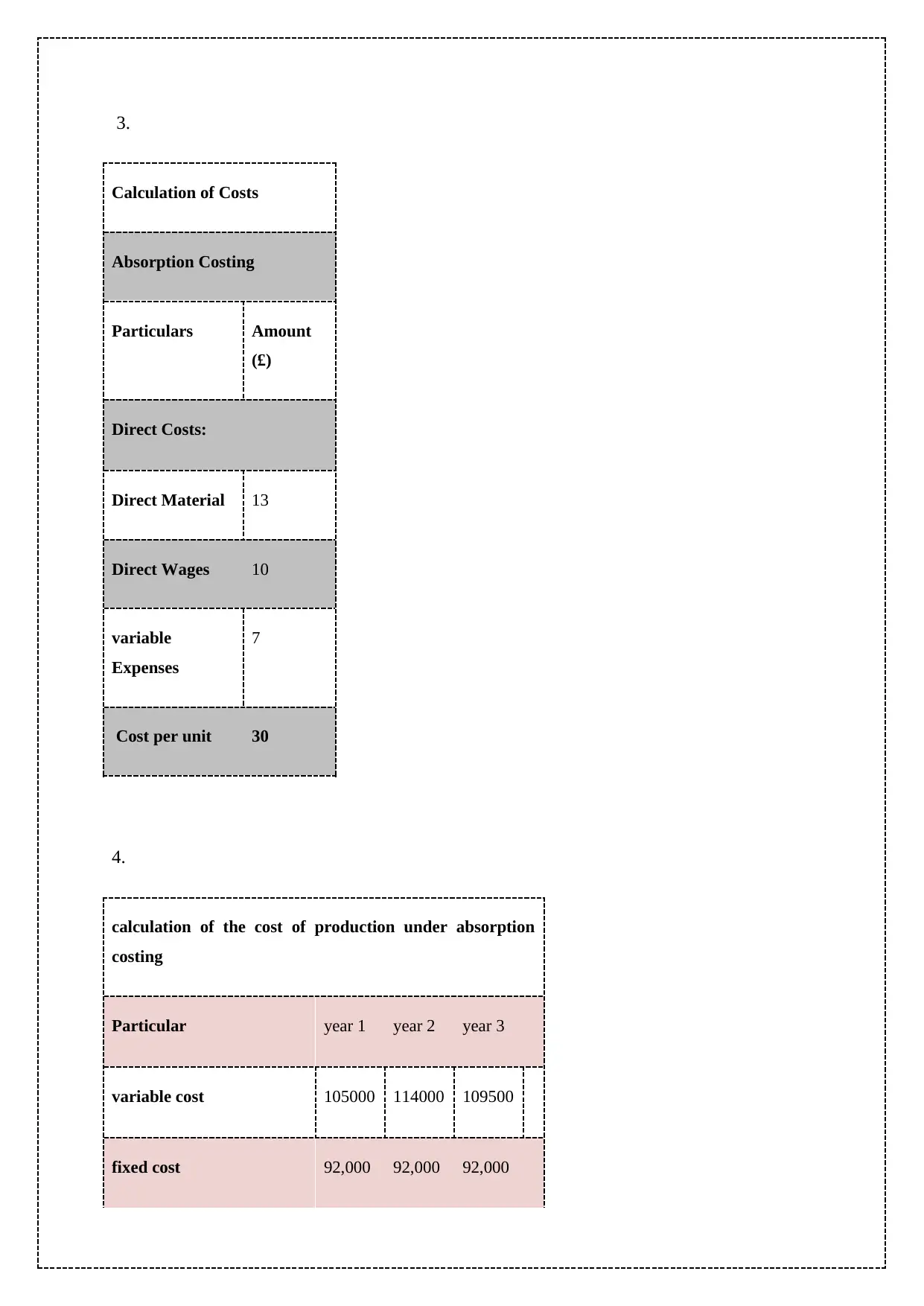
3.
Calculation of Costs
Absorption Costing
Particulars Amount
(£)
Direct Costs:
Direct Material 13
Direct Wages 10
variable
Expenses
7
Cost per unit 30
4.
calculation of the cost of production under absorption
costing
Particular year 1 year 2 year 3
variable cost 105000 114000 109500
fixed cost 92,000 92,000 92,000
Calculation of Costs
Absorption Costing
Particulars Amount
(£)
Direct Costs:
Direct Material 13
Direct Wages 10
variable
Expenses
7
Cost per unit 30
4.
calculation of the cost of production under absorption
costing
Particular year 1 year 2 year 3
variable cost 105000 114000 109500
fixed cost 92,000 92,000 92,000
⊘ This is a preview!⊘
Do you want full access?
Subscribe today to unlock all pages.

Trusted by 1+ million students worldwide
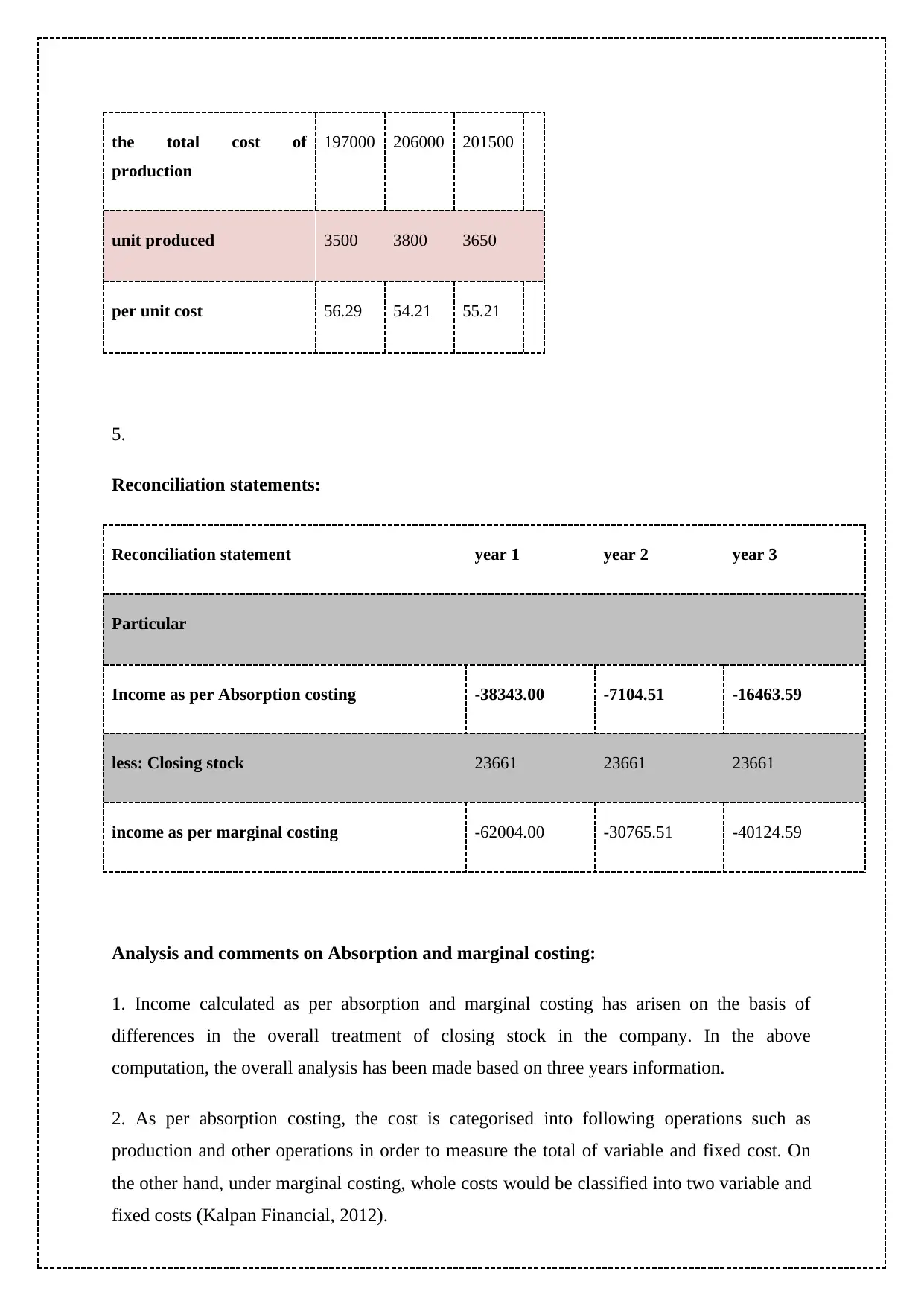
the total cost of
production
197000 206000 201500
unit produced 3500 3800 3650
per unit cost 56.29 54.21 55.21
5.
Reconciliation statements:
Reconciliation statement year 1 year 2 year 3
Particular
Income as per Absorption costing -38343.00 -7104.51 -16463.59
less: Closing stock 23661 23661 23661
income as per marginal costing -62004.00 -30765.51 -40124.59
Analysis and comments on Absorption and marginal costing:
1. Income calculated as per absorption and marginal costing has arisen on the basis of
differences in the overall treatment of closing stock in the company. In the above
computation, the overall analysis has been made based on three years information.
2. As per absorption costing, the cost is categorised into following operations such as
production and other operations in order to measure the total of variable and fixed cost. On
the other hand, under marginal costing, whole costs would be classified into two variable and
fixed costs (Kalpan Financial, 2012).
production
197000 206000 201500
unit produced 3500 3800 3650
per unit cost 56.29 54.21 55.21
5.
Reconciliation statements:
Reconciliation statement year 1 year 2 year 3
Particular
Income as per Absorption costing -38343.00 -7104.51 -16463.59
less: Closing stock 23661 23661 23661
income as per marginal costing -62004.00 -30765.51 -40124.59
Analysis and comments on Absorption and marginal costing:
1. Income calculated as per absorption and marginal costing has arisen on the basis of
differences in the overall treatment of closing stock in the company. In the above
computation, the overall analysis has been made based on three years information.
2. As per absorption costing, the cost is categorised into following operations such as
production and other operations in order to measure the total of variable and fixed cost. On
the other hand, under marginal costing, whole costs would be classified into two variable and
fixed costs (Kalpan Financial, 2012).
Paraphrase This Document
Need a fresh take? Get an instant paraphrase of this document with our AI Paraphraser
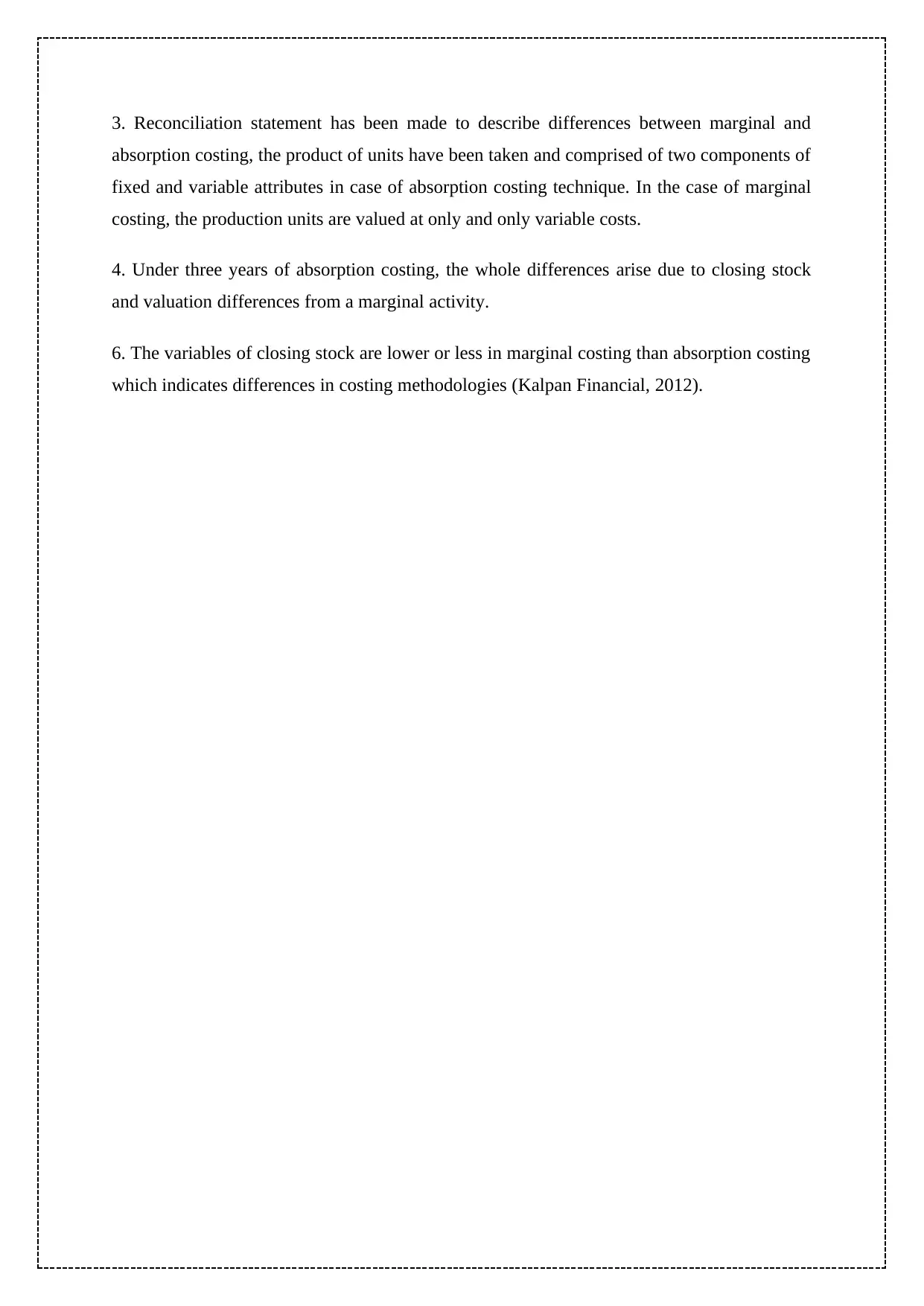
3. Reconciliation statement has been made to describe differences between marginal and
absorption costing, the product of units have been taken and comprised of two components of
fixed and variable attributes in case of absorption costing technique. In the case of marginal
costing, the production units are valued at only and only variable costs.
4. Under three years of absorption costing, the whole differences arise due to closing stock
and valuation differences from a marginal activity.
6. The variables of closing stock are lower or less in marginal costing than absorption costing
which indicates differences in costing methodologies (Kalpan Financial, 2012).
absorption costing, the product of units have been taken and comprised of two components of
fixed and variable attributes in case of absorption costing technique. In the case of marginal
costing, the production units are valued at only and only variable costs.
4. Under three years of absorption costing, the whole differences arise due to closing stock
and valuation differences from a marginal activity.
6. The variables of closing stock are lower or less in marginal costing than absorption costing
which indicates differences in costing methodologies (Kalpan Financial, 2012).
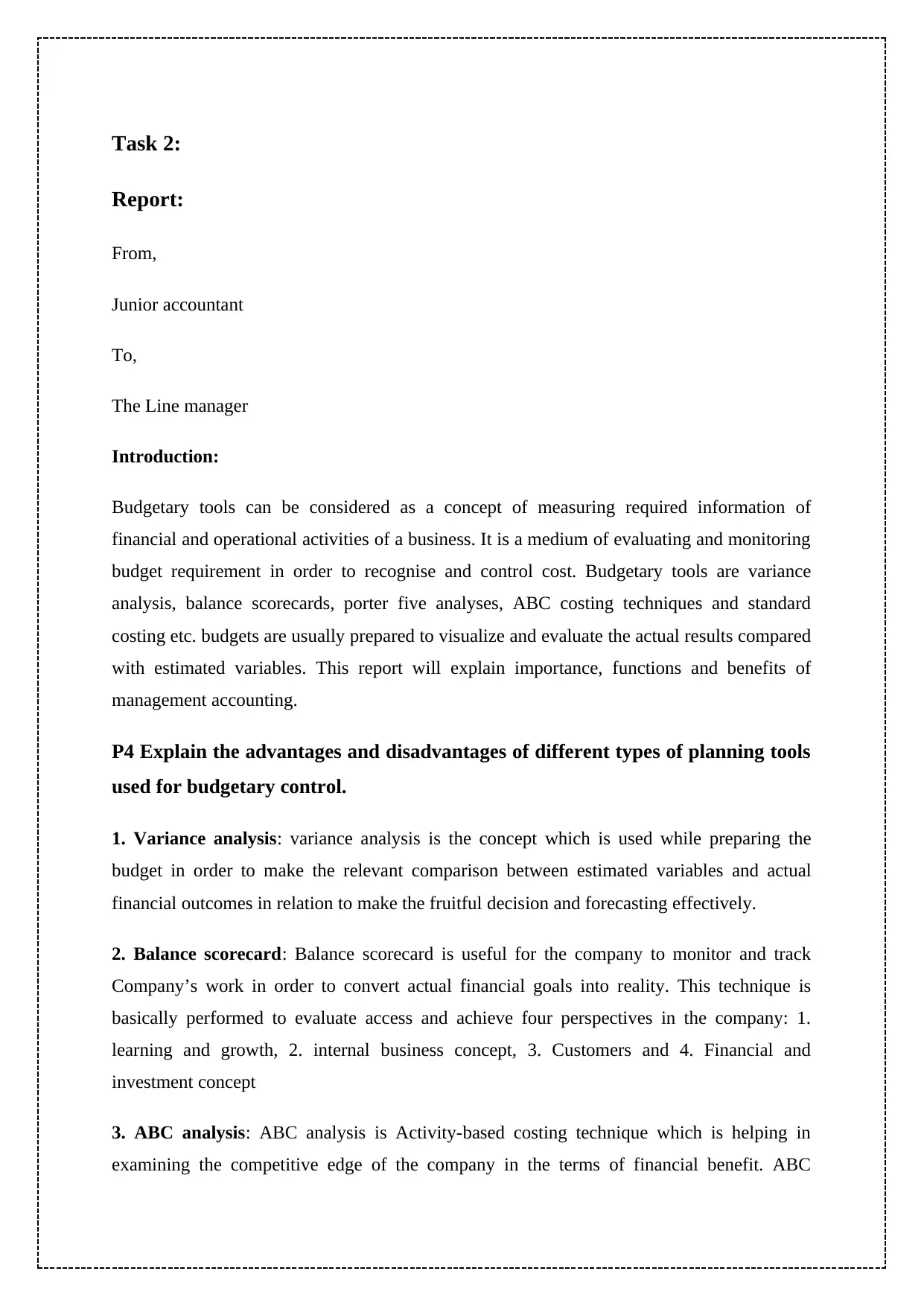
Task 2:
Report:
From,
Junior accountant
To,
The Line manager
Introduction:
Budgetary tools can be considered as a concept of measuring required information of
financial and operational activities of a business. It is a medium of evaluating and monitoring
budget requirement in order to recognise and control cost. Budgetary tools are variance
analysis, balance scorecards, porter five analyses, ABC costing techniques and standard
costing etc. budgets are usually prepared to visualize and evaluate the actual results compared
with estimated variables. This report will explain importance, functions and benefits of
management accounting.
P4 Explain the advantages and disadvantages of different types of planning tools
used for budgetary control.
1. Variance analysis: variance analysis is the concept which is used while preparing the
budget in order to make the relevant comparison between estimated variables and actual
financial outcomes in relation to make the fruitful decision and forecasting effectively.
2. Balance scorecard: Balance scorecard is useful for the company to monitor and track
Company’s work in order to convert actual financial goals into reality. This technique is
basically performed to evaluate access and achieve four perspectives in the company: 1.
learning and growth, 2. internal business concept, 3. Customers and 4. Financial and
investment concept
3. ABC analysis: ABC analysis is Activity-based costing technique which is helping in
examining the competitive edge of the company in the terms of financial benefit. ABC
Report:
From,
Junior accountant
To,
The Line manager
Introduction:
Budgetary tools can be considered as a concept of measuring required information of
financial and operational activities of a business. It is a medium of evaluating and monitoring
budget requirement in order to recognise and control cost. Budgetary tools are variance
analysis, balance scorecards, porter five analyses, ABC costing techniques and standard
costing etc. budgets are usually prepared to visualize and evaluate the actual results compared
with estimated variables. This report will explain importance, functions and benefits of
management accounting.
P4 Explain the advantages and disadvantages of different types of planning tools
used for budgetary control.
1. Variance analysis: variance analysis is the concept which is used while preparing the
budget in order to make the relevant comparison between estimated variables and actual
financial outcomes in relation to make the fruitful decision and forecasting effectively.
2. Balance scorecard: Balance scorecard is useful for the company to monitor and track
Company’s work in order to convert actual financial goals into reality. This technique is
basically performed to evaluate access and achieve four perspectives in the company: 1.
learning and growth, 2. internal business concept, 3. Customers and 4. Financial and
investment concept
3. ABC analysis: ABC analysis is Activity-based costing technique which is helping in
examining the competitive edge of the company in the terms of financial benefit. ABC
⊘ This is a preview!⊘
Do you want full access?
Subscribe today to unlock all pages.

Trusted by 1+ million students worldwide
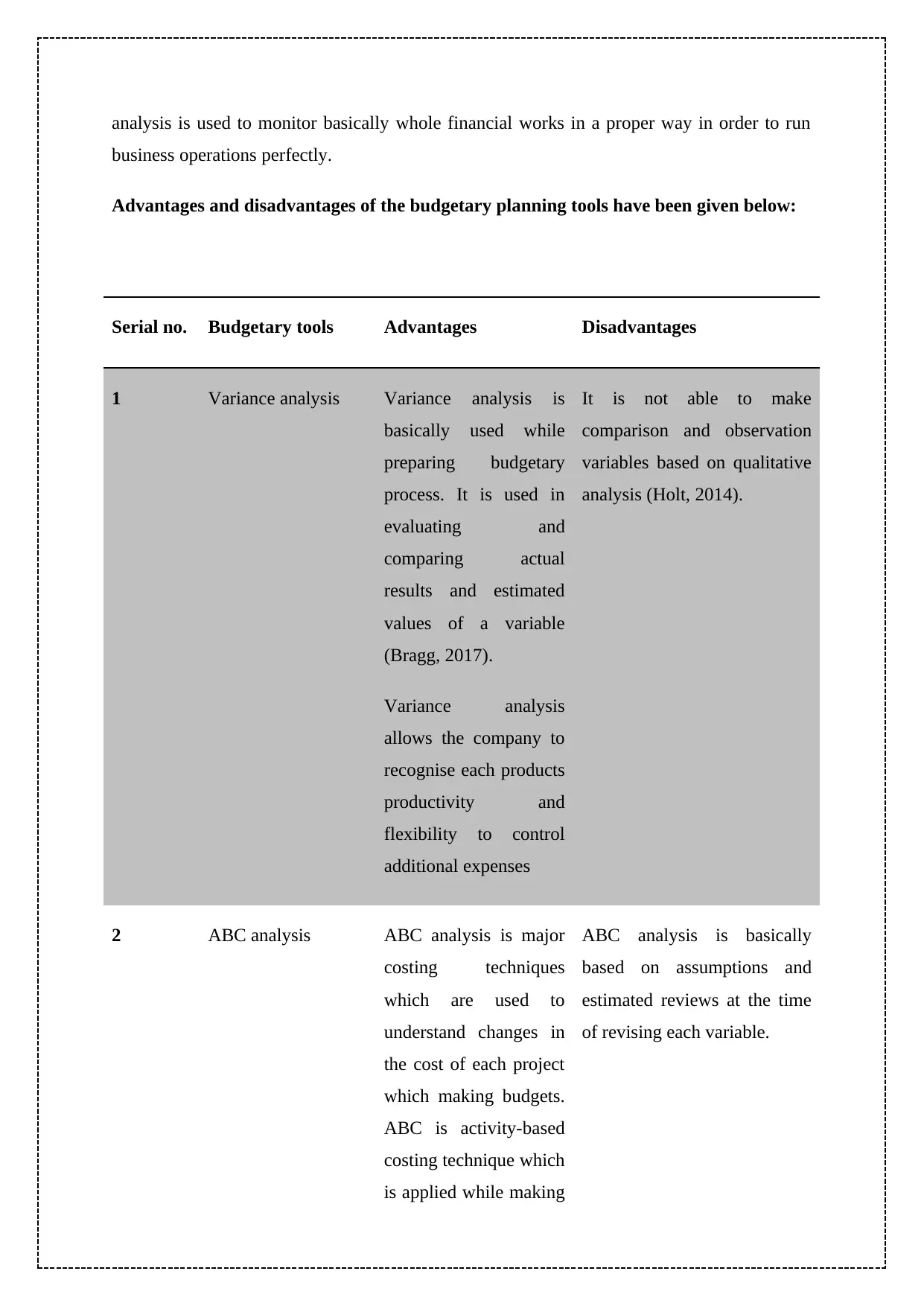
analysis is used to monitor basically whole financial works in a proper way in order to run
business operations perfectly.
Advantages and disadvantages of the budgetary planning tools have been given below:
Serial no. Budgetary tools Advantages Disadvantages
1 Variance analysis Variance analysis is
basically used while
preparing budgetary
process. It is used in
evaluating and
comparing actual
results and estimated
values of a variable
(Bragg, 2017).
Variance analysis
allows the company to
recognise each products
productivity and
flexibility to control
additional expenses
It is not able to make
comparison and observation
variables based on qualitative
analysis (Holt, 2014).
2 ABC analysis ABC analysis is major
costing techniques
which are used to
understand changes in
the cost of each project
which making budgets.
ABC is activity-based
costing technique which
is applied while making
ABC analysis is basically
based on assumptions and
estimated reviews at the time
of revising each variable.
business operations perfectly.
Advantages and disadvantages of the budgetary planning tools have been given below:
Serial no. Budgetary tools Advantages Disadvantages
1 Variance analysis Variance analysis is
basically used while
preparing budgetary
process. It is used in
evaluating and
comparing actual
results and estimated
values of a variable
(Bragg, 2017).
Variance analysis
allows the company to
recognise each products
productivity and
flexibility to control
additional expenses
It is not able to make
comparison and observation
variables based on qualitative
analysis (Holt, 2014).
2 ABC analysis ABC analysis is major
costing techniques
which are used to
understand changes in
the cost of each project
which making budgets.
ABC is activity-based
costing technique which
is applied while making
ABC analysis is basically
based on assumptions and
estimated reviews at the time
of revising each variable.
Paraphrase This Document
Need a fresh take? Get an instant paraphrase of this document with our AI Paraphraser
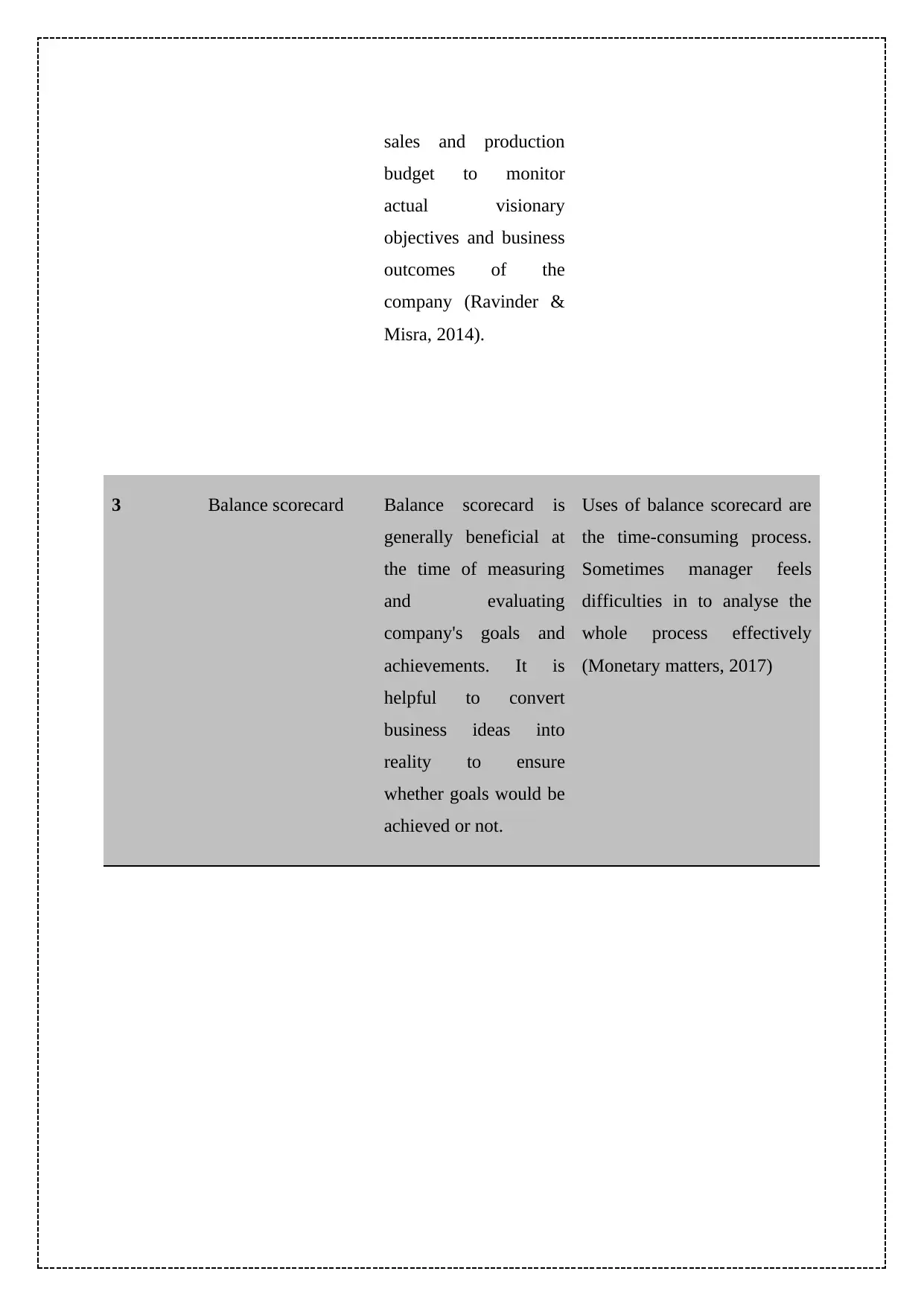
sales and production
budget to monitor
actual visionary
objectives and business
outcomes of the
company (Ravinder &
Misra, 2014).
3 Balance scorecard Balance scorecard is
generally beneficial at
the time of measuring
and evaluating
company's goals and
achievements. It is
helpful to convert
business ideas into
reality to ensure
whether goals would be
achieved or not.
Uses of balance scorecard are
the time-consuming process.
Sometimes manager feels
difficulties in to analyse the
whole process effectively
(Monetary matters, 2017)
budget to monitor
actual visionary
objectives and business
outcomes of the
company (Ravinder &
Misra, 2014).
3 Balance scorecard Balance scorecard is
generally beneficial at
the time of measuring
and evaluating
company's goals and
achievements. It is
helpful to convert
business ideas into
reality to ensure
whether goals would be
achieved or not.
Uses of balance scorecard are
the time-consuming process.
Sometimes manager feels
difficulties in to analyse the
whole process effectively
(Monetary matters, 2017)
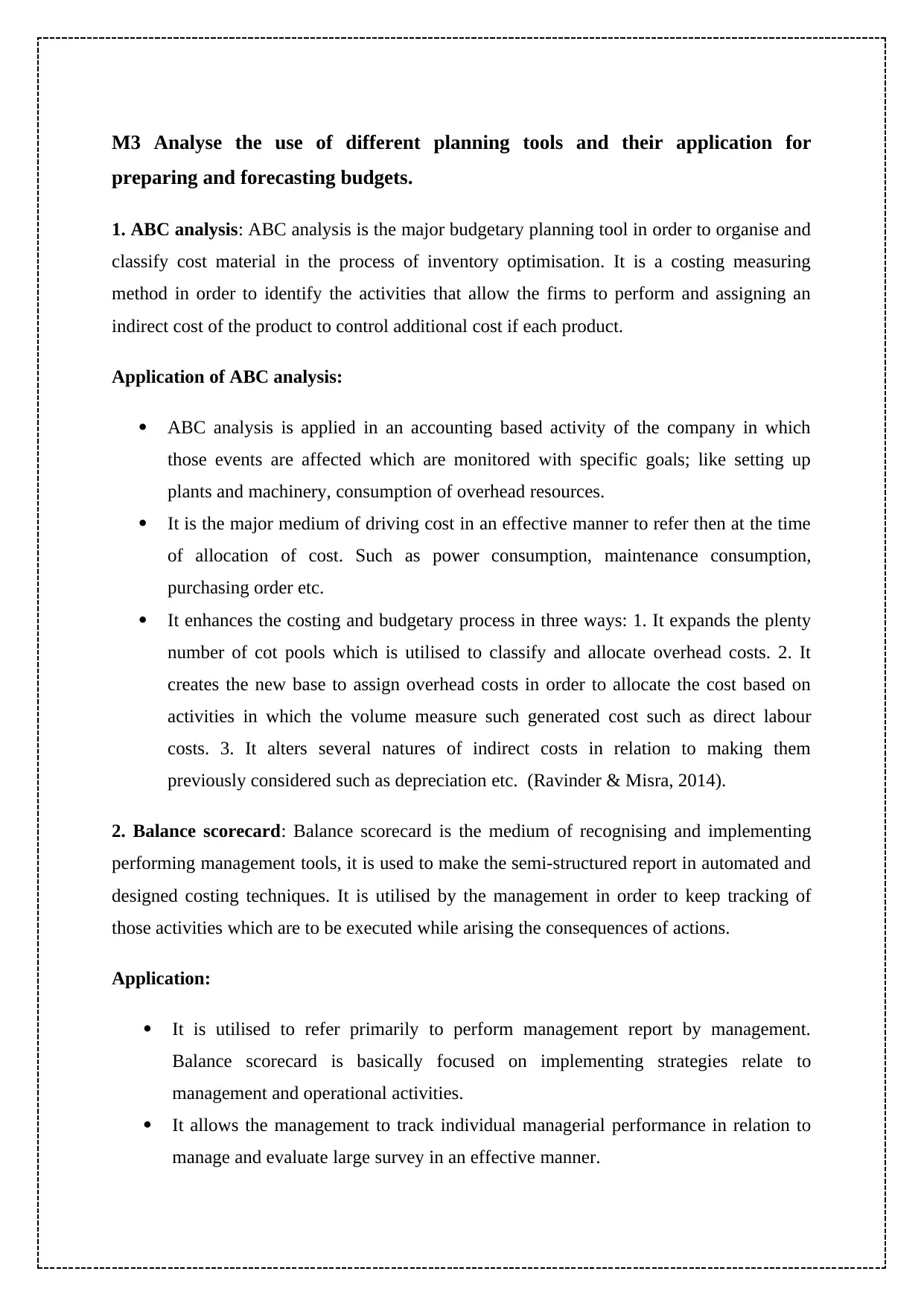
M3 Analyse the use of different planning tools and their application for
preparing and forecasting budgets.
1. ABC analysis: ABC analysis is the major budgetary planning tool in order to organise and
classify cost material in the process of inventory optimisation. It is a costing measuring
method in order to identify the activities that allow the firms to perform and assigning an
indirect cost of the product to control additional cost if each product.
Application of ABC analysis:
ABC analysis is applied in an accounting based activity of the company in which
those events are affected which are monitored with specific goals; like setting up
plants and machinery, consumption of overhead resources.
It is the major medium of driving cost in an effective manner to refer then at the time
of allocation of cost. Such as power consumption, maintenance consumption,
purchasing order etc.
It enhances the costing and budgetary process in three ways: 1. It expands the plenty
number of cot pools which is utilised to classify and allocate overhead costs. 2. It
creates the new base to assign overhead costs in order to allocate the cost based on
activities in which the volume measure such generated cost such as direct labour
costs. 3. It alters several natures of indirect costs in relation to making them
previously considered such as depreciation etc. (Ravinder & Misra, 2014).
2. Balance scorecard: Balance scorecard is the medium of recognising and implementing
performing management tools, it is used to make the semi-structured report in automated and
designed costing techniques. It is utilised by the management in order to keep tracking of
those activities which are to be executed while arising the consequences of actions.
Application:
It is utilised to refer primarily to perform management report by management.
Balance scorecard is basically focused on implementing strategies relate to
management and operational activities.
It allows the management to track individual managerial performance in relation to
manage and evaluate large survey in an effective manner.
preparing and forecasting budgets.
1. ABC analysis: ABC analysis is the major budgetary planning tool in order to organise and
classify cost material in the process of inventory optimisation. It is a costing measuring
method in order to identify the activities that allow the firms to perform and assigning an
indirect cost of the product to control additional cost if each product.
Application of ABC analysis:
ABC analysis is applied in an accounting based activity of the company in which
those events are affected which are monitored with specific goals; like setting up
plants and machinery, consumption of overhead resources.
It is the major medium of driving cost in an effective manner to refer then at the time
of allocation of cost. Such as power consumption, maintenance consumption,
purchasing order etc.
It enhances the costing and budgetary process in three ways: 1. It expands the plenty
number of cot pools which is utilised to classify and allocate overhead costs. 2. It
creates the new base to assign overhead costs in order to allocate the cost based on
activities in which the volume measure such generated cost such as direct labour
costs. 3. It alters several natures of indirect costs in relation to making them
previously considered such as depreciation etc. (Ravinder & Misra, 2014).
2. Balance scorecard: Balance scorecard is the medium of recognising and implementing
performing management tools, it is used to make the semi-structured report in automated and
designed costing techniques. It is utilised by the management in order to keep tracking of
those activities which are to be executed while arising the consequences of actions.
Application:
It is utilised to refer primarily to perform management report by management.
Balance scorecard is basically focused on implementing strategies relate to
management and operational activities.
It allows the management to track individual managerial performance in relation to
manage and evaluate large survey in an effective manner.
⊘ This is a preview!⊘
Do you want full access?
Subscribe today to unlock all pages.

Trusted by 1+ million students worldwide
1 out of 22
Related Documents
Your All-in-One AI-Powered Toolkit for Academic Success.
+13062052269
info@desklib.com
Available 24*7 on WhatsApp / Email
![[object Object]](/_next/static/media/star-bottom.7253800d.svg)
Unlock your academic potential
Copyright © 2020–2025 A2Z Services. All Rights Reserved. Developed and managed by ZUCOL.





